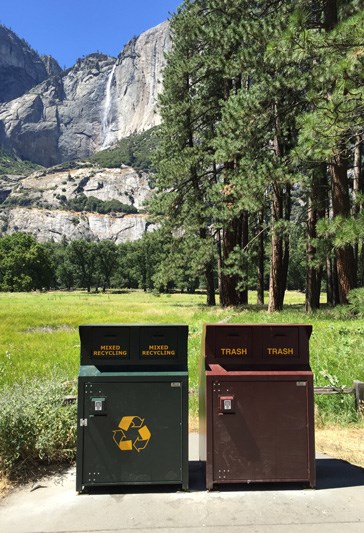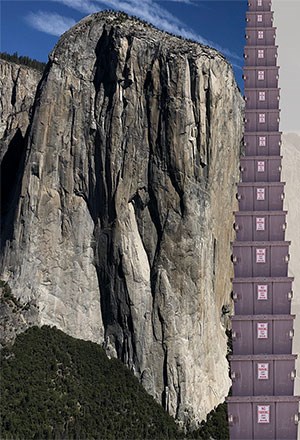
Because Some Mountains are more Beautiful than Others....Over four million visitors come to Yosemite National Park every year. Between visitors and park staff we end up with nearly 2,200 tons of garbage annually. This is not the legacy anyone intends to leave behind. In the late winter/early spring of 2016, Yosemite launched an exciting new program to do something about it: the Zero Landfill Initiative. With help from Subaru of America (Subaru), the National Parks Conservation Association (NPCA), and the Yosemite Conservancy, the park set an ambitious target of diverting 80% of our waste from the landfill by the end of 2017. Subaru, a Centennial partner of the National Park Service, was approached by the NPCA to see if the company’s expertise in waste management could be used to help the national parks. Subaru’s Indiana facility led the auto industry, becoming the first zero landfill auto assembly plant in the United States in 2004. Since that time, Subaru has been consulted by many businesses for advice on how to follow in its zero waste footsteps. Over the next three years, in partnership with NPCA, Subaru will bring its expertise in a pilot program with three national parks, Yosemite, Denali, and Grand Teton, to help us reach our own waste reduction goals. Recycling and reducing waste are not new to Yosemite. The park began a recycling program in 1975, collecting aluminum, glass, and paper. In the years since then, Yosemite and its concessioners built a strong program that currently diverts about 60 percent of the total waste stream from going into the Mariposa County landfill. In addition to recycling, the overall amount of Yosemite’s garbage heading to the landfill is reduced by practices such as buying in bulk to reduce unnecessary packaging and by re-using materials, such as those used for certain building repairs. 
Recycle and Protect WildlifeEfforts to reduce trash and collect recycling are not just good management practices—they also help protect wildlife, especially bears, by keeping them from eating trash. Historically, we fed bears for visitor entertainment, but bears that become accustomed to eating human food change their behavior, putting people and themselves at risk. Improving the way we manage trash and recycling along with decades of educating visitors about proper storage of food and disposal of trash paid off. In 2015, Yosemite had its lowest number of bear incidents since the park started tracking these cases: 76 total. Adding more recycling infrastructure and renewed efforts at visitor education will help keep this number low—and bears alive. The Zero Landfill Initiative at Yosemite will build on these achievements and the work of our active Sustainability Team, which addresses a wider range of sustainability issues, such as water and energy conservation. Initially the Zero Landfill Initiative will focus on upgrades to infrastructure, such as replacing many of the “Half-Dome” shaped trash and recycling cans throughout the park, which were among the first wildlife-proof containers used in a national park setting. More water bottle refilling stations are in the plans, too. Eventually, we hope to expand collection of compostable food waste to both park employees and visitors. In addition, with help from Subaru, we are working with other community partners and tour companies to provide more information about what and how to recycle in the park as well as how to reduce the amount of waste visitors bring with them on trips to the park. According to a study conducted in the park in July 2015, about 20 percent of what is in Yosemite’s trash is actually something that we already target for recycling. The most common recyclable items we find in our trash are single-use water bottles, aluminum cans, and paper. Even glass bottles show up in our trash cans; if they end up in the landfill they take thousands of years to decompose. By installing more recycling containers and adding labels with photographs of what can be recycled, the percentage of recyclables should go down. While in the park, dispose of your recycling and trash properly. In places managed by NPS staff (i.e. campgrounds, visitor centers, the museum, bus stops, and day use picnic areas) Yosemite has mixed recycling. This means everything goes in just one bin unless otherwise labeled. Styrofoam is not recyclable in our system, neither are bubble wrap, plastic bags, or unlabeled plastic. At hotels and eating establishments operated by the park concessioner, there are separate recycling containers for each type of material collected (paper, glass, aluminum, and plastic). You can go even further at food service facilities by using the “organic waste” cans to reroute the organic material and compostable paper and plastic. This includes the biodegradable tableware like paper napkins and biodegradable utensils. 
What You Can Do to be a Yosemite Zero HeroLeave excess packaging behind!When preparing for your trip, choose gear and food with the least amount of packaging or get rid of excess packaging before you leave home. Do your best to avoid buying single use products. Not only does it reduce waste when you are here, but saves you packing space! Use Refillables!Bring as many reusable items as possible, such as water bottles, travel mugs, utensils, food containers, cooking gas canisters, and reusable bags. Use refillable propane cylinders for camp stoves and lanterns. Bonus: Refillables not only reduce waste, but save you (and us) money. Use Rechargables!Use lanterns, flashlights, and other devices that rely on renewable or rechargeable batteries. Small portable solar chargers work well for keeping cell phones and other electronics running. Dispose of trash and recycling properly.Be sure to put true garbage in the garbage can and recyclable items in the recycling containers. Disposing of waste properly and recycling helps keep Yosemite green and protects wildlife. Don’t abandon unneeded gear.If you don’t need your camping gear after your trip to the park, but don’t want to take it home with you (you can’t take it on the plane or you don’t need it, etc.), please consider donating it to an organization that can use it. 
Fun Fact!In one year Yosemite National Park produces about 2,200 tons of garbage per year. The garbage could fill almost 4,000 dumpsters. The dumpsters stacked would stand over 16,000 feet tall, towering over any peak in Yosemite. |
Last updated: June 15, 2023

